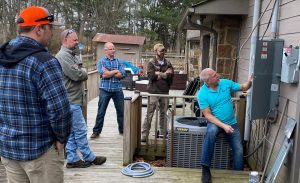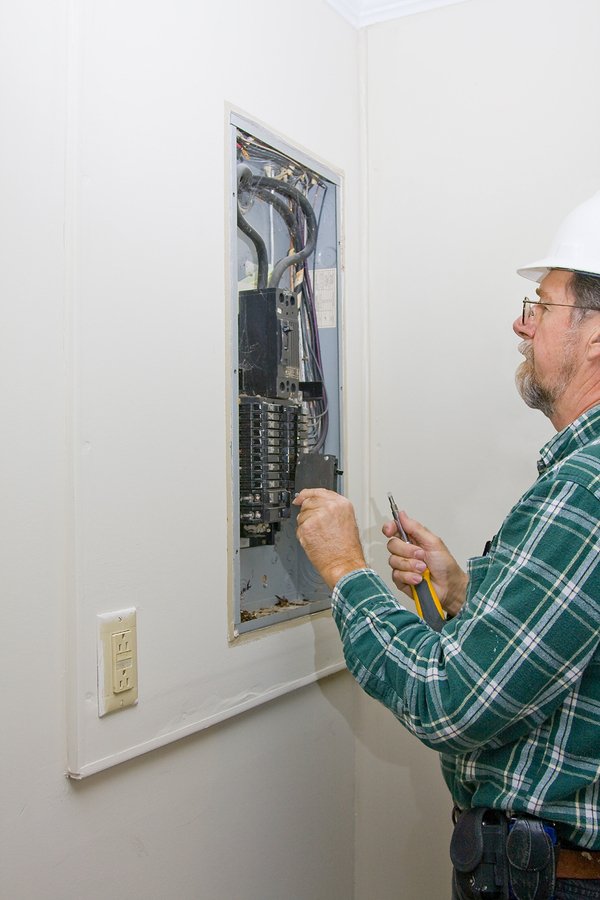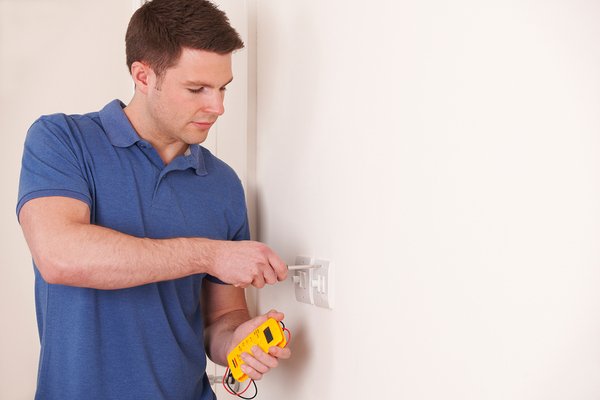Home inspectors should inspect the electrical system in a home carefully, not just to make sure it works properly, but to make sure it is safe. Of all the home systems, the electrical is the most dangerous. A problem with the electrical system can result in fire, property destruction, injury, and even death.

You must remove the cover to examine the electrical panel.
The most important part of the electrical system inspection is the electrical panel. It’s where the electricity enters the home and is disbursed throughout the rooms.
Begin your inspection by looking outside the home at the wires coming into the electrical panel. Check that the connection is fastened to the house securely, and note any trees that are interfering with the wiring. Visible wiring should appear to be in good condition and covered with insulation, with no metal showing.
Wiring in newer neighborhoods is underground. In these cases, home inspectors are not allowed to open these main boxes and inspect the connections inside.
While home inspectors do much of their jobs through observation, you must delve more deeply into the electrical system. Although homeowners can find directions online for inspecting their own electrical systems, this is a task they should never undertake. The voltage levels inside an electrical panel can kill a person who is not properly trained in inspecting them.
Electrical Panel Cautions
Inspectapedia warns never to touch an electrical panel if you notice anything dangerous, such as a missing grounding electrode. Also, do not touch any service entry cables or other wires or attempt to pry the electrical panel cover off with a tool. Never touch any part of the electrical system if there is water on the floor. If you feel any heat or tingling when touching any part of the electrical system, stop and do not go any further. Recommend an evaluation by a licensed electrician.
Inspecting the electrical system requires that you remove the cover on the electrical panel. At first, this may seem scary, but once you learn to do it safely, it will be easier.
Getting the cover off the box usually means removing four blunt-tipped screws. It’s important the screws be blunt; if they are sharp, they may pierce wires coming into the box and cause an electrical shock. You can’t know if the screws are blunt or sharp until you remove them, but once you do, if you see they are sharp, do not put them back in. You can replace them with blunt-tipped screws if you have them; otherwise, inform the homeowner of this unsafe condition.
The first thing to make note of is that nothing inside the panel should be hot or be humming. If it is, do not go forward with your inspection of the electrical system and refer the homeowner to a licensed electrician. Also, if you see fuses instead of circuit breakers, this is a big no-no. Fuses are now illegal in most parts of the country and must be replaced with circuit breakers.

There is a lot to look for when examining a home’s electrical panel.
Check the size of the main breaker. This is often written on the circuit breaker in the panel, but sometimes the main breaker is outside. Smaller than 100 amps is not enough for today’s family’s electrical needs. A new breaker panel is $1,000-$2,000, so this expense should be noted in your report.
Check also that no wires are loose. Loose wires can generate heat and create unsafe conditions. Also, check that the wires used are the right gauge for the breakers. Look for curves in each of the attached wires as well. Wires that are straight and have no curves are considered too tight and may eventually pop off.
Copper or Aluminum Wiring?
An important notation to make when you first look inside the electrical box is whether copper or aluminum wire is being used. Aluminum wiring was used in many houses built between 1965 and 1973, due to the high cost of copper at the time. At least 1.5 million houses were built using aluminum wiring. More problems come from using aluminum wiring, as it tends to overheat more often, causing fires.
Check the wires coming into the electrical box to see if they are copper-colored or silver (aluminum). Aluminum wiring is now considered unsafe and should be noted on your report.
Checking the Wiring and Connections
Whereas it is impractical to rewire an entire house, an electrician can replace outlets and wall switches with newer, safer models that will work better with aluminum wiring.
Once you have determined what type of wire is used, check the wires coming into the circuits. Each circuit should have only one wire connected to it. If any circuits have more than one wire connected to them, it could cause the breaker to overheat and should be noted.
Also, check the wires connected to the busboard. Multiple grounding wires can be under each bonding screw, but you cannot have more than one neutral wire under a bonding screw. If you find multiple neutral wires under a bonding screw, you must note this because it is unsafe.
Check Panel Conditions
Look to make sure the panel itself is clean and rust-free. Note if any insulation is coming off of any wires and exposing them, as this is hazardous. In addition, look for any burned or singed areas that may signify unsafe conditions.
Check also that the panel itself is grounded with a bracket and grounding screw. If a hot wire comes loose and touches the box, you could get electrocuted by touching the box, but the grounding bracket prevents this by directing the excess electricity outside where rebar redistributes it in the ground.
Sometimes watching someone else inspect a particular home system helps more than a description of what to do. Watch this home inspection company or this licensed electrician perform electrical inspections on YouTube.
Inspecting Wall Outlets
By comparison, testing wall outlets throughout the home is easy. You need a multimeter to test wall outlets. The red probe goes in the right side of the outlet and the black goes in the left. At this point, you should get a reading of about 120 volts. After you get this reading, switch the black probe to the oval hole to check the ground wire.
A reading of well below 120 volts can cause your lighting or electrical appliances to work poorly, while a reading higher than 120 volts is cause for concern because it can cause a fire.
The reason for high or low readings could be loose or dirty wires at the outlet or in the circuit box. Flag these for follow-up by a licensed electrician.
When you are going through the house testing outlets, you will doubtlessly find some that are occupied with plugs. When you remove them to test the outlet, note if the plug is warm or if the cord cover is soft or melting. Both of these conditions are concerns.

Besides electrical panels, you should also inspect switches and outlets.
Inspecting Light Switches and Fixtures
The first step to take in inspecting light switches and fixtures is to turn them on and off to see if they work. If they do not, you can use a non-contact voltage tester to determine if the current is getting to the switch, but this is not a necessary part of the inspection. You may simply note that the switch is not working and recommend it be examined by a licensed electrician.
Ground Fault Interrupter Circuits
Many older homes don’t have ground wires, which isn’t considered safe by today’s standards. GFCI — ground fault interrupter circuits — were invented in 1973. These interrupt the flow of current in case of an emergency, such as an overload or the presence of water. These outlets are identifiable by their small, rectangular red buttons that pop out, indicating current has been shut off, although a home could have one, main GFCI breaker in the electrical panel.
You will most often find these types of outlets installed in areas where they might come into contact with water, such as bathrooms, the garage, or outdoors. The absence of any GFCIs is a safety hazard and should be noted.
Finally, your inspection report should note any open circuit boxes, missing cover plates, exposed or loose wiring, or any other unsafe electrical condition you observe. ASHI has compiled a list of what home inspectors shall inspect and describe, as well as what they are not required to inspect.
ICA School teaches prospective home inspectors everything they need to know to do their jobs. We have four individual modules on electricity, including electrical theory, service drops, wire gauges, wire material and types, main and sub electrical panels, outlets, switches, fixtures, smoke detectors, and carbon monoxide detectors.
With inspection training from ICA, you will be well-qualified to perform all aspects of home inspections. To get started earning your home inspection certificate, enroll now.







